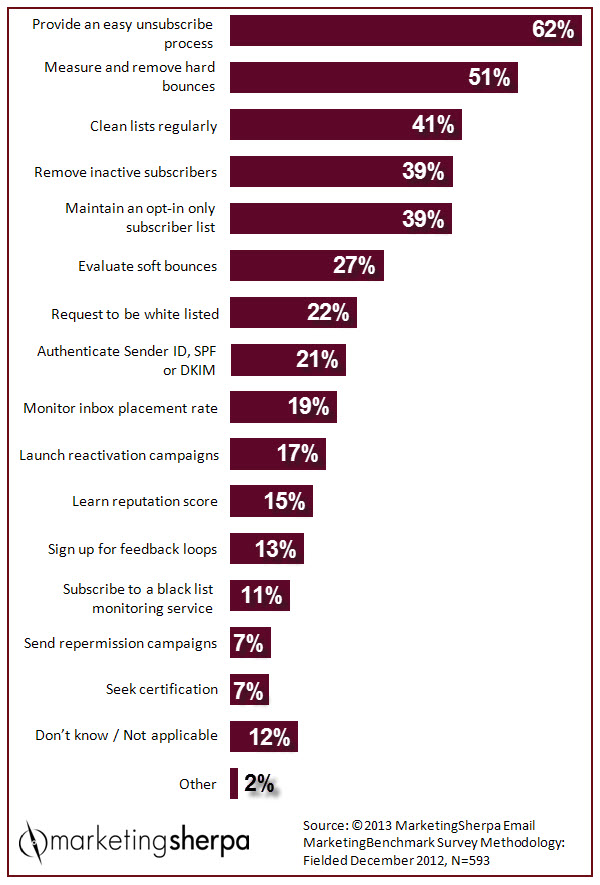Email Deliverability: Only 39% of marketers maintain an opt-in only subscriber list
Email marketing is an interesting animal. It has often been compared to direct mail. However, unlike direct mail, sending irrelevant and even annoying messages can really burn your entire email marketing program.
With direct mail, if a recipient didn’t like your message, they can drop it straight in the recycling bin.
However, with email marketing, your email recipients can affect your ability to reach other potential customers by, for example, marking your email as spam. Brutal.
So, to help you improve your company’s email deliverability, we asked marketers about this topic in the MarketingSherpa 2013 Email Marketing Benchmark Report …
Q: Which of the following tactics is your organization using to improve email deliverability rates? Please select all that apply.
As always, we asked your peers for their take on this data …
When is a subscriber an inactive subscriber?
For people who remove inactive subscribers, typically, how long should they be inactive for?
– Ariel Geifman, Director of Marketing, Mintigo
This is a great question, Ariel. It is the marketing equivalent of “What is the meaning of life?” on some levels.
Because, I’d say – to both questions – the answer varies.
For example, how long is your sales cycle? How frequently do you send email? Can you tell if these folks are engaging with your company in other ways? How segmented are your email sends? Do you send triggered emails?
Whatever the length, it is probably worthwhile to consider a re-engagement campaign before removing these inactive subscribers.
But, answering a question with more questions is a wholly unfulfilling answer, I readily admit. So, to give you some straightforward numbers to chew on, I did a quick dive into the MarketingSherpa Library to see how some companies define inactive subscriber.
Some examples:
- Eventful, an event Web service, considered subscribers inactive if they had not engaged with an email for five months – Email Marketing: Weekly newsletter sees 400% lift in reactivation of inactive subscribers with personalization.
- TBC Corporation, which owns automobile parts and tires businesses like Midas and Tire Kingdom, considered subscribers inactive if they had not opened or clicked an email in six months or longer – Email Marketing: Delivery rate increases from 60% to 99% by separating inactive subscribers.
- CNET tracks inactivity at different levels. People who hadn’t opened an email in the last 60 days, 120 days, and 180 days, for example, and then engages in a re-engagement campaign based on these levels of inactivity before removing inactive subscribers – Email Marketing: CNET win-back campaign sees 8% subscriber re-engagement.
- For the most drastic campaign in this area, Indianapolis Symphony Orchestra sent a re-engagement email to everyone on the list (including active subscribers), and removed all subscribers who didn’t click “yes” they wanted to continue subscribing – How Cutting a House List 95% Helped Double Sales: 5 steps.









